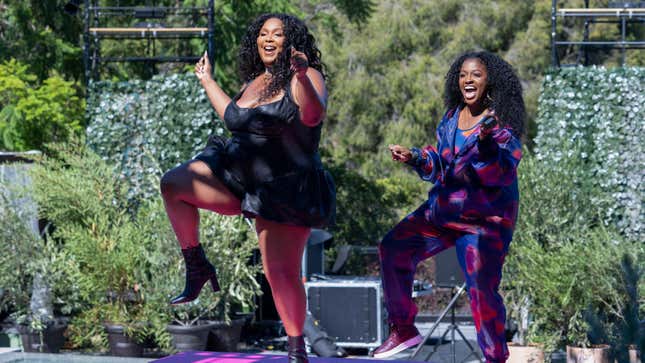‘Lizzo’s Watch Out for the Big Grrrls’ Is Ripping Dance’s Obsession with Tiny White Bodies to Shreds
Women who were once considered “too big” or "too fat" for dance say the new Amazon series changes everything.
In Depth

Trigger warning: This story addresses body dysmorphia and weight loss.
Nearly every dancer who wasn’t straight-sized or stick thin growing up (as the dance industry would prefer it) keeps a mental notebook of horror stories that involve an influential authority figure making a blasé comment about their bodies that altered the course of their lives.
Alexandra Patrick, a 30-year-old freelance dance teacher and choreographer from Dallas, Texas, knows this intimately. As one of just two girls of color in her local dance studio growing up, Patrick hit puberty earlier than some of her peers, developing curves faster than her classmates. When she struggled with a position in ballet class, her teachers said, “It’s just because your hips aren’t made to do this.” On her first day of college classes, she approached a teacher to thank her for class, and was immediately told, “You and I both know you’ll never be a ballerina.” Unsure what to make of her noticeably-not-straight hair and muscular, curvy body, another dance teacher told her, “You’re my little wild woman. I want you to look like an animal.” These repeated microaggressions and belittlement inevitably chipped away at Patrick’s sense of self. But, as she loved dance more than anything, she did what she needed to do to keep pursuing her dream.
“I just loved the act of dancing, the act of performing, the rehearsals, the soreness, literally every part of being a dancer was my identity, so it was hard when people assumed I must play basketball. No, I’m a dancer,” Patrick told Jezebel. “Then they’d say, ‘Oh, well, hip hop must be your favorite.’ Actually, I liked lyrical and contemporary. I was constantly being labeled and put into boxes based on what people saw—not even based on my performance, but based on my figure.”
After decades of being othered both as a woman of color and as a person in a body that didn’t fit the “status quo,” Patrick had internalized the messaging that her body simply wasn’t right for the dance industry: If the industry wouldn’t make space for her, then she’d have to shrink to fit into it. Her weight yo-yoed to extremes. She auditioned for So You Think You Can Dance three times and never made it. Eventually, she stopped dancing altogether. For years, she had to watch the girls with long legs, washboard abs, and beautiful extensions—the ones dubbed elegant and graceful (who were often white)—book the gigs she dreamt about. Then, along came Lizzo.
As a musician, Lizzo has been a trailblazer for body positivity in every sense of the word. She’s been outspoken about swatting away haters who have said she isn’t fit enough to get through a performance or who were made visibly uncomfortable by a woman in a Black, size-neutral body who declared herself “beautiful” and “sexy.”
Lizzo also made waves in the dance industry by hiring a group of “Big Grrrls”—her plus-size or curvy background dancers, most of whom were also women of color. She created opportunities for the women who had previously been systematically shut out of the commercial dance world due to their size or body type, regardless of their talent. Now, with the premiere of her new Amazon competition reality series, Lizzo’s Watch Out for the Big Grrrls, the idea that women can be both incredible dancers and sexy at any size is getting a massive, new platform. In an industry where there was often only space for one token “big girl” on set, former and current professional dancers say this sort of body diversity is life-changing for women. Long overdue, the show reframes the narrative for women who’ve been repeatedly denigrated for daring to look different from the lean muscular body type historically labeled as the “ideal” candidate.
-

-

-

-

-

-

-

-

-

-

-

-

-

-

-

-

-

-

-

-

-

-

-

-

-

-

-

-

-

-

-

-

-

-

-

-

-

-

-

-








































